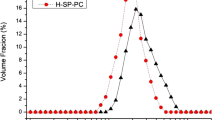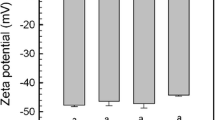Abstract
Soybean lecithin contains primarity PC, PE, and PI. Fractionation of these phospholipids (PL) is desirable for certain applications. Ethanol was used to fractionate PC and PI, which have different solubilities in this solvent. Various concentrations of ethanol (90, 95, and 100%) and ethanol/gum ratios (0.5, 1.0, 1.5, 2.0, and 2.5) were used. Ethanol concentration significantly influenced the yield of the PC-enriched fraction and the PC and PI fractionation: The highest ethanol concentration resulted in the highest yield of PC fraction, the most PC in the PC fraction, and the most PI in the PI fraction. The ethanol/gum ratio significantly affected the yield of PC-enriched fraction, but did not affect the relative PL composition of the PC-enriched fraction. Ethanol of 90% concentration with a solvent/gum ratio of 3 was used for further large-scale fractionation. Such fractionation resulted in a PC-enriched fraction containing 73% PC, 24% PE, and 3% PI based on the total PL content, whereas the PI fraction contained 26% PC, 35% PE, and 39% PI. Functional properties of these two purified fractions, i.e., surface tension reduction, emulsion stability, and oxidative stability, were investigated. The PI-enriched fraction had a much lower critical micelle concentration than the PC-enriched fraction, which suggests the PI-enriched fraction has a higher surface tension reduction capability. For the emulsion stability test, the PI-enriched fraction performed better than the PC fraction in both water-in-oil and oil-in-water emulsions. An oxidative stability test showed that these PL were very stable to lipid oxidation.
Similar content being viewed by others
References
Wendel, R., Lecithin, in Kirk-Othmer Encyclopedia of Chemical Technology, 14th edn., edited by M. Howe-Grant, John Wiley & Sons, New York, 1995, Vol. 15, pp. 192–209.
Central Soya, http://www.centralsoya.com (accessed May 2002).
Cherry, J.P., and W.H. Kramer, Plant Sources of Lecithin, in Lecithins: Sources, Manufacture & Uses, edited by B.F. Szuhaj American Oil Chemists’ Society, Champaign, 1989, pp. 16–31.
Schneider, M., Fractionation and Purification of Lecithin, in, pp. 109–130.
Hui, Y.H., By-Products Utilization, in Bailey’s Industrial Oil & Fat Products, Vol. 4: Edible Oil & Fat Products: Processing Technology, edited by Y.H. Hui, John Wiley & Sons, New York, 1996, pp. 603–630.
Krog, N.J., Food Emulsifiers and Their Chemical and Physical Properties, in Food Emulsions, edited by S.E. Friberg and K. Larsson, Marcel Dekker, New York, 1997, pp. 141–188.
Stauffer, C.E., Emulsions and Foams, in Emulsifiers, Eagan Press, St. Paul, 1999, pp. 1–14.
McClements, D.J., Food Emulsions: Principles, Practice, and Techniques, CRC Press, Boca Raton, 1998, pp. 185–233.
Dashiell, G.L., Lecithin in Food Processing Applications, in Lecithins: Sources, Manufacture & Uses, edited by B.F. Szuhaj, American Oil Chemists’ Society, Champaign, 1989, pp. 213–224.
Official Methods and Recommended Practices of the American Oil Chemists’ Society, 4th edn., AOCs Press, Champaign, 1994
Wu, Y., and T. Wang, Phospholipid Class and FA Compositions of Modified Soybeans Processed with Two Extraction Methods, J. Am. Oil Chem. Soc. 80:127–132 (2003).
SAS, SAS User’s Guide, SAS Institute, Cary, NC, 1984.
Robyt, J.F., and B.J. White, Biochemical Techniques: Theory and Practice, Waveland Press, Prospect Heights, IL, 1987, pp. 291–320.
Hamm, D.L., E.G. Hammond, V. Parvanah, and H.E. Snyder, The Determination of Peroxides by the Stamm Method, J. Am. Oil Chem. Soc. 42:920–922 (1965).
Fujita, S. and K. Suzuki, Significant Surface Activity Shown by the Mixture of Partially Deacylated Lipids, in Phospholipids: Biochemical, Pharmaceutical, and Analytical Considerations, edited by I. Hamin and G. Pepeu, Plenum Press, New York, 1989, pp. 267–271.
Stauffer, C.E., Food Emulsifiers, in Emulsifiers, Eagan Press, St. Paul, 1999, pp. 25–45.
Evans, C.D., P.M. Cooney, C.R. Scholfield, and H.J. Dutton, Soybean “Lecithin” and Its Fractions as Metal Inactivating Agents, J. Am. Oil Chem. Soc. 31:295–297 (1954).
Dziedzic, S.Z., and B.J.F. Hudson, Phosphatidyl Ethanolamine as a Synergist for Primary Antioxidants in Edible Oils, 61:1042–1045 (1984).
Author information
Authors and Affiliations
Corresponding author
About this article
Cite this article
Wu, Y., Wang, T. Soybean lecithin fractionation and functionality. J Amer Oil Chem Soc 80, 319–326 (2003). https://doi.org/10.1007/s11746-003-0697-x
Received:
Accepted:
Issue Date:
DOI: https://doi.org/10.1007/s11746-003-0697-x




